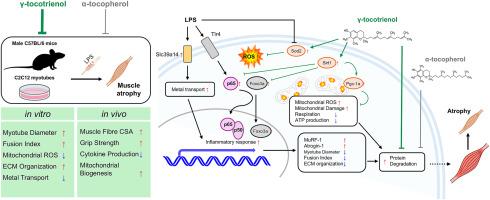γ-Tocotrienol attenuates oxidative stress and preserves mitochondrial function in inflammation-induced muscle atrophy
IF 11.9
1区 生物学
Q1 BIOCHEMISTRY & MOLECULAR BIOLOGY
引用次数: 0
Abstract
Muscle atrophy, marked by the loss of skeletal muscle mass and strength, presents a major health concern with diverse etiologies, including chronic inflammation. Effective interventions are urgently needed for its prevention and treatment. Although α-tocopherol, the most abundant form of vitamin E, is known for its antioxidant benefits in muscle health, γ-tocotrienol exhibits superior antioxidant and anti-inflammatory properties. This study investigates the protective effects of γ-tocotrienol against muscle atrophy and compares its efficacy with α-tocopherol. Muscle atrophy was induced in differentiated C2C12 myotubes using lipopolysaccharide (LPS), with vitamin E pre-treatment applied prior to LPS challenge. Myotube morphology, expression of atrophy-related markers, and underlying molecular pathways were examined through immunofluorescence, western blotting, and quantitative proteomics. LPS treatment induced significant myotube atrophy without affecting cell viability. Notably, γ-tocotrienol pre-treatment preserved myotube size and suppressed key atrophy markers, including the E3 ubiquitin ligases MuRF-1 and Fbxo32/Atrogin-1. Proteomic analysis quantified 5,371 proteins and revealed that γ-tocotrienol alleviated atrophy by enhancing extracellular matrix organization and attenuating oxidative stress and mitochondrial dysfunction. These protective effects were further confirmed in vivo, where γ-tocotrienol administration preserved muscle strength, suppressed pro-inflammatory signaling, and restored mitochondrial biogenesis in LPS-treated mice. Collectively, these findings demonstrate that γ-tocotrienol offers superior protection against muscle atrophy compared to α-tocopherol, highlighting its therapeutic potential for individuals at risk of muscle wasting.

γ-生育三烯醇在炎症诱导的肌肉萎缩中减轻氧化应激并保持线粒体功能。
肌肉萎缩,以骨骼肌质量和力量的丧失为特征,是一个主要的健康问题,其病因多种多样,包括慢性炎症。预防和治疗该病迫切需要有效的干预措施。α-生育酚是维生素E中含量最丰富的一种,以其对肌肉健康的抗氧化作用而闻名,而γ-生育三烯醇则表现出卓越的抗氧化和抗炎特性。本研究探讨了γ-生育三烯醇对肌肉萎缩的保护作用,并与α-生育酚进行了比较。用脂多糖(LPS)诱导分化的C2C12肌管肌肉萎缩,并在LPS刺激前进行维生素E预处理。通过免疫荧光、western blotting和定量蛋白质组学检测肌管形态、萎缩相关标志物的表达和潜在的分子途径。LPS处理引起明显的肌管萎缩,但不影响细胞活力。值得注意的是,γ-生育三烯醇预处理保留了肌管大小,抑制了关键的萎缩标志物,包括E3泛素连接酶MuRF-1和Fbxo32/Atrogin-1。蛋白质组学分析量化了5371个蛋白,发现γ-生育三烯醇通过增强细胞外基质组织、减轻氧化应激和线粒体功能障碍来减轻萎缩。这些保护作用在体内得到进一步证实,在lps处理的小鼠中,γ-生育三烯醇可以保持肌肉力量,抑制促炎信号,并恢复线粒体生物发生。总的来说,这些发现表明,与α-生育酚相比,γ-生育三烯醇对肌肉萎缩具有更好的保护作用,突出了其对有肌肉萎缩风险的个体的治疗潜力。
本文章由计算机程序翻译,如有差异,请以英文原文为准。
求助全文
约1分钟内获得全文
求助全文
来源期刊

Redox Biology
BIOCHEMISTRY & MOLECULAR BIOLOGY-
CiteScore
19.90
自引率
3.50%
发文量
318
审稿时长
25 days
期刊介绍:
Redox Biology is the official journal of the Society for Redox Biology and Medicine and the Society for Free Radical Research-Europe. It is also affiliated with the International Society for Free Radical Research (SFRRI). This journal serves as a platform for publishing pioneering research, innovative methods, and comprehensive review articles in the field of redox biology, encompassing both health and disease.
Redox Biology welcomes various forms of contributions, including research articles (short or full communications), methods, mini-reviews, and commentaries. Through its diverse range of published content, Redox Biology aims to foster advancements and insights in the understanding of redox biology and its implications.
 求助内容:
求助内容: 应助结果提醒方式:
应助结果提醒方式:


